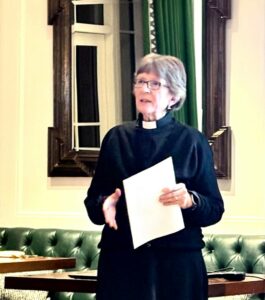Our last Speaker and Supper Meeting brought us Revd. Canon Nicola Stanley to speak to us about her work and experiences as a woman in the church.
Nicola is from East Yorkshire and went to school in York. After leaving school she spent time in Italy and Germany, then moved to London where she became a member of the Chartered Institute for Personnel Development. She also worked for British Steel, followed by an Italian shipping company.
Nicola was ordained deacon in 2002 and priest in 2003, having trained in Salisbury. She retired from the position of Revd. Canon at Bristol Cathedral last year and is now a priest based at All Saint’s Church in Clifton.
She talked about the fact that being in the church is a 6 days a week job and, as a woman and mother, it can be challenging to reconcile the job with family life, often missing her children’s sports day and other important events.
She was keen to explain that she is not a vicar but is a priest in charge of a parish, as she is sometimes called.
Throughout her Anglo-Catholic working life, Nicola experienced a considerable amount of antagonistic behaviour from male colleagues who oppose women priests. Even being completely ignored in conversation within groups of male priests.
Most of those who oppose women’s ordination tend to be conservative evangelicals or conservative Anglo-Catholics.
Nicola explained that the TV programme ‘The Vicar of Dibley’ helped portray the life and tribulations of women priests and to improve their image.
The Church of England’s parliament took the decision to allow women’s ordination in 1992 and the first women were ordained in 1994.
Female priests face various difficulties, including societal expectations, potential discrimination, and challenges in achieving senior leadership positions.
Opposition to women priests in the Church of England stems from theological arguments rooted in biblical interpretations, traditional Anglican beliefs, and concerns about unity with other Christian denominations like the Roman Catholic and Orthodox churches, which do not allow women priests. According to Catholic doctrine, priests are supposed to represent the likeness of Jesus, a male figure. The Catholic argument is therefore that women are not suitable to represent the male figure of Christ.
Nicola explained that currently 50% of people coming to ordinance in the Church of England are women.
Thank you Nicola for a very interesting talk about the role of women within the church.


